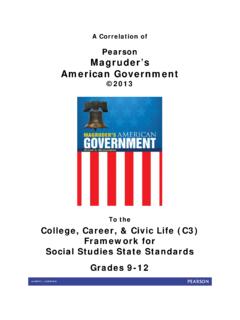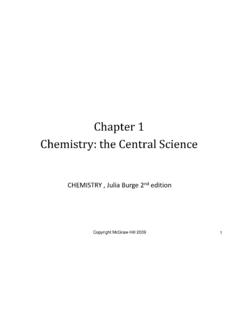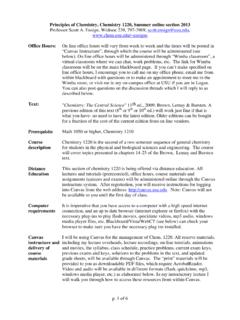Transcription of CO Chemistry Central Science 2015 - Final
1 A Correlation of Pearson Chemistry The Central Science 13th Edition, AP Edition 2015 Brown LeMay Bursten Murphy Woodward Stoltzfus To the Colorado Academic Standards for High School Science Physical Science AP is a trademark registered and/or owned by the College Board, which was not involved in the production of, and does not endorse, this product. Chemistry : The Central Science , 13th Edition, AP Edition 2015 to the Colorado Academic Standards for High School Science Physical Science 2 SE = Student Edition Colorado Academic Standards for High School Science Physical Science Chemistry : The Central Science 13th Edition, AP Edition, 2015 Content Area: Science Grade Level Expectations: High School Standard: 1.
2 Physical Science Prepared Graduates: Observe, explain, and predict natural phenomena governed by Newton's laws of motion, acknowledging the limitations of their application to very small or very fast objects Concepts and skills students master: 1. Newton's laws of motion and gravitation describe the relationships among forces acting on and between objects, their masses, and changes in their motion - but have limitations Evidence Outcomes Students Can: a. Gather, analyze and interpret data and create graphs regarding position, velocity and acceleration of moving objects (DOK 1-3) SE: 166-167, 419 (Figure ), 422 (Figure ) b. Develop, communicate and justify an evidence-based analysis of the forces acting on an object and the resultant acceleration produced by a net force (DOK 1-3) Opportunity to address this outcome can be found on the following page: SE: 166 (A Closer Look), 169 c.
3 Develop, communicate and justify an evidence-based scientific prediction regarding the effects of the action-reaction force pairs on the motion of two interacting objects (DOK 1-3) Opportunity to address this outcome can be found on the following pages: SE: 593-594, 593 (Figure ), 594 (Figures & ), 595 (Figure ), 597 (Sample Exercise ), 599-600, 600 (Figure ) d. Examine the effect of changing masses and distance when applying Newton's law of universal gravitation to a system of two bodies (DOK 1-2) Opportunity to address this outcome can be found on the following page: SE: 401 e. Identify the limitations of Newton's laws in extreme situations (DOK 1) This standard is not addressed at this course level.
4 Chemistry : The Central Science , 13th Edition, AP Edition 2015 to the Colorado Academic Standards for High School Science Physical Science 3 SE = Student Edition Colorado Academic Standards for High School Science Physical Science Chemistry : The Central Science 13th Edition, AP Edition, 2015 Prepared Graduates: Apply an understanding of atomic and molecular structure to explain the properties of matter, and predict outcomes of chemical and nuclear reactions Concepts and skills students master: 2. Matter has definite structure that determines characteristic physical and chemical properties Evidence Outcomes Students Can: a. Develop, communicate, and justify an evidence-based scientific explanation supporting the current model of an atom (DOK 1-3) SE: 43-47, 47-49, 74 (# ), 75 (# ) b.
5 Gather, analyze and interpret data on chemical and physical properties of elements such as density, melting point, boiling point, and conductivity (DOK 1-2) SE: 11, 55, 273-274, 276, 278-279, 281, 283, 285, 286, 487 c. Use characteristic physical and chemical properties to develop predictions and supporting claims about elements' positions on the periodic table (DOK 1-2) SE: 53, 55, 278-280, 281-283, 283-284, 285-286, 286-287, 293 (# , ), 294 (# ), 295 (# ) d. Develop a model that differentiates atoms and molecules, elements and compounds, and pure substances and mixtures (DOK 2-3) Opportunity to address this outcome can be found on the following pages: SE: 4 (Figure ), 7, 8 (Figure ), 11 Prepared Graduates: Apply an understanding of atomic and molecular structure to explain the properties of matter, and predict outcomes of chemical and nuclear reactions Concepts and skills students master: 3.
6 Matter can change form through chemical or nuclear reactions abiding by the laws of conservation of mass and energy Evidence Outcomes Students Can: a. Recognize, analyze, interpret, and balance chemical equations (synthesis, decomposition, combustion, and replacement) or nuclear equations (fusion and fission) (DOK 1-2) SE: 82-86, 86-88, 103-106, 112 (# ), 113 (# ), 114 (# ), 911-912, 932, 937, 939, 947 (# ), 949 (# ) Chemistry : The Central Science , 13th Edition, AP Edition 2015 to the Colorado Academic Standards for High School Science Physical Science 4 SE = Student Edition Colorado Academic Standards for High School Science Physical Science Chemistry : The Central Science 13th Edition, AP Edition, 2015 b.
7 Predict reactants and products for different types of chemical and nuclear reactions (DOK 1-2) SE: 86-89, 112 (# ), 113 (# , , , ), 114 (# ), 117 (# ) c. Predict and calculate the amount of products produced in a chemical reaction based on the amount of reactants (DOK 1-2) SE: 103-106, 106-109, 109-110, 113 (# ), 116 (# ), 117 (# , ), 118 (# ) d. Examine, evaluate, question, and ethically use information from a variety of sources and media to investigate the conservation of mass and energy (DOK 1-2) Opportunity to address this standard can be found on the following pages: SE: 42, 74 (# ), 82, 113 (# ), 170, 198-199 ( Chemistry Put To Work) Prepared Graduates: Apply an understanding of atomic and molecular structure to explain the properties of matter, and predict outcomes of chemical and nuclear reactions Concepts and skills students master: 4.
8 Atoms bond in different ways to form molecules and compounds that have definite properties Evidence Outcomes Students Can: a. Develop, communicate, and justify an evidence-based scientific explanation supporting the current models of chemical bonding (DOK 1-3) SE: 60-61, 300-302, 306-309, 311, 315-319, 320-321, 322, 334 (# ), 335 (# ), 347-355, 356-357, 358-365, 365-372 b. Gather, analyze, and interpret data on chemical and physical properties of different compounds such as density, melting point, boiling point, pH, and conductivity (DOK 1-2) SE: 124-127, 132-134, 274-277, 302, 310-312, 314-315, 333 (# ), 335 (# , , ), 498-502, 502, 503-504, 684-687 c. Use characteristic physical and chemical properties to develop predictions and supporting claims about compounds' classification as ionic, polar or covalent (DOK 1-2) SE: 302-304, 305-306, 309-315, 333 (# ), 335 (# ), 336 (# ) d.
9 Describe the role electrons play in atomic bonding (DOK 1) SE: 298, 300-302, 306-308, 334 (# ), 335 (# ) Chemistry : The Central Science , 13th Edition, AP Edition 2015 to the Colorado Academic Standards for High School Science Physical Science 5 SE = Student Edition Colorado Academic Standards for High School Science Physical Science Chemistry : The Central Science 13th Edition, AP Edition, 2015 e. Predict the type of bonding that will occur among elements based on their position in the periodic table (DOK 1-2) SE: 268-271, 272-273, 274, 276, 301, 307, 309-310, 315, 335 (# ), 336 (# ) Prepared Graduates: Apply an understanding that energy exists in various forms, and its transformation and conservation occur in processes that are predictable and measurable Concepts and skills students master: 5.
10 Energy exists in many forms such as mechanical, chemical, electrical, radiant, thermal, and nuclear, that can be quantified and experimentally determined Evidence Outcomes Students Can: a. Develop, communicate, and justify an evidence-based scientific explanation regarding the potential and kinetic nature of mechanical energy (DOK 1-3) SE: 169, 175-179, 204 (# ) b. Use appropriate measurements, equations and graphs to gather, analyze, and interpret data on the quantity of energy in a system or an object (DOK 1-3) SE: 164, 166-168, 169-173, 173-175, 175-178, 179-181, 181-186, 187-189, 189-194, 202 (# ), 203 (# , ), 204-206, 457-460, 929, 935, 937 c. Use direct and indirect evidence to develop predictions of the types of energy associated with objects (DOK 2-3) SE: 167-168, 169, 174-175, 194-199, 208 (# ) d.















